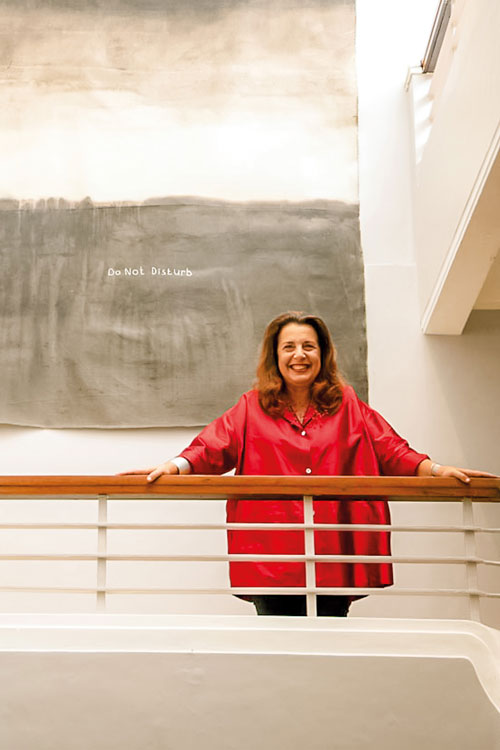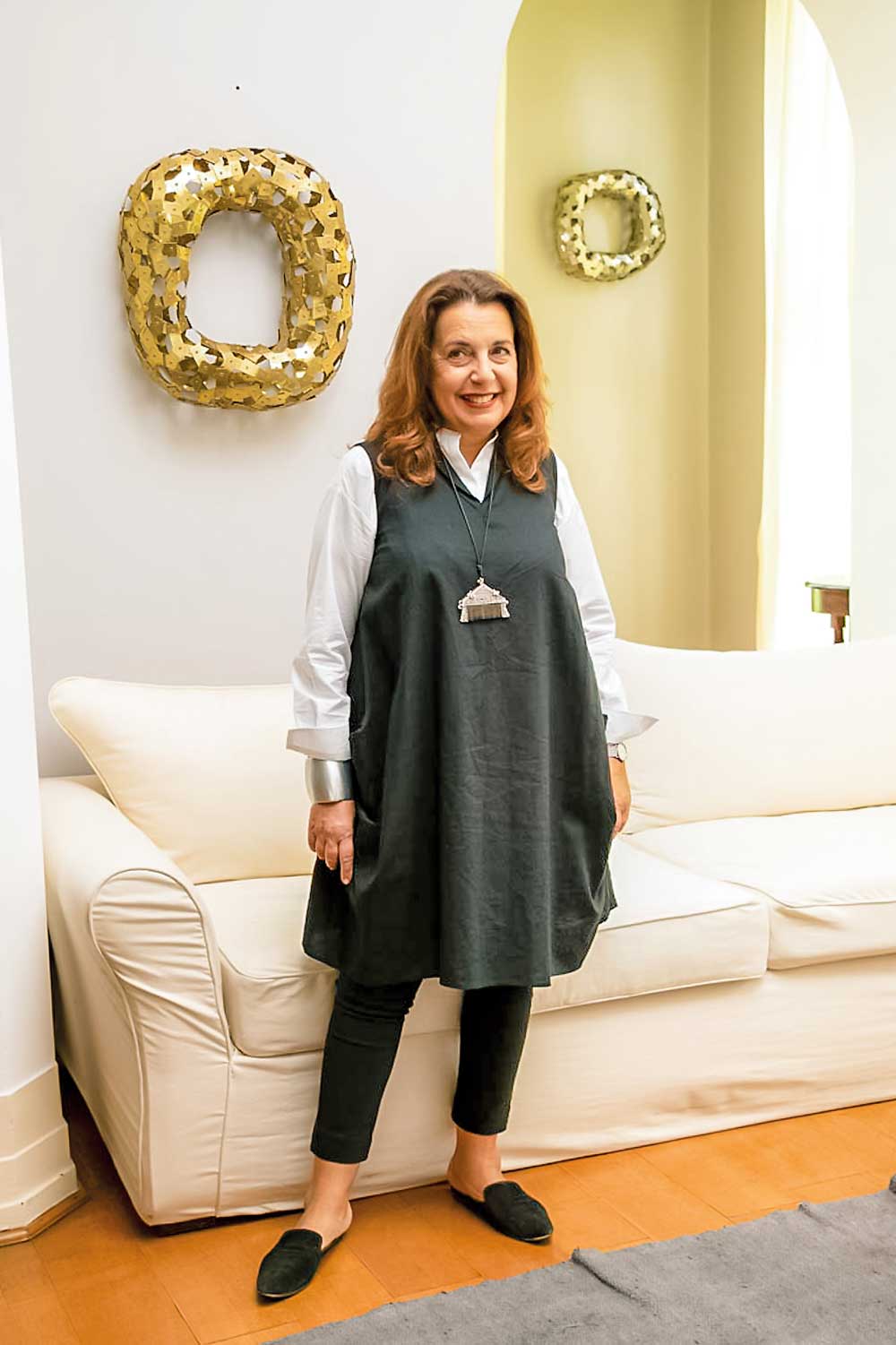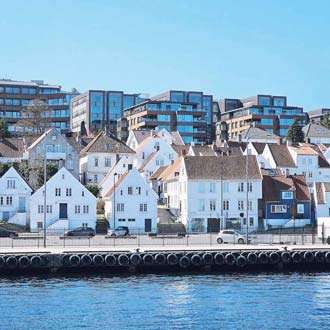
Words: Tina Edward Gunawardhana
Photographs: Siyath Gowin Plus
Susanna Orlando speaks on her role as an Italian gallerist and her perspective of
Sri Lankan art in the global gallery
Agallerist of international repute, Susanna Orlando visited Sri Lanka at the invitation of the Italian Ambassador Rita Manella, an art connoisseur herself. Susanna was born in Florence and was exposed to art from a young age. Her father Angelo Orlando was also a famous gallerist. After finishing her studies Susanna travelled abroad and garnered experience in some of the world’s best galleries which she then applied at her own gallery. Tasked with curating and displaying a selection of contemporary Italian art at Ambassador Manella’s residence in Colombo, Susanna showcased an eclectic collection of art which stimulated the senses. Whilst in Sri Lanka Susanna also addressed a cross section of students from the Faculty of Visual Arts where she explained to them the important role a gallerist plays in the life of an artist.

What swayed you to become a gallerist?
I believe I was born a gallerist. My father was a gallerist and from the time I was 6 years old
I used to accompany him to his gallery. While there I discovered that the smell of paint made me very happy. When I was 18 my father allowed me to convert a small storage space he had into a gallery. At that time I was juggling my studies in law with selling art. Although I was studying to be a lawyer, after six years I realised that the passion to be a gallerist was far greater. I stayed in that gallery for 38 years and moved to Pietra Santa which has a great energy for art with an abundance of artists and galleries.
Are you an artist yourself?
Of course not! I just like to follow many artists. I think I have a special sensibility to recognize good artists. I think being able to spot a good artist is something that is in my DNA.
I have a good intuition when it comes to art and identifying good artists.
What brings you to Sri Lanka?
I have known the Italian Ambassador Rita Manella for over 45 years as she was a regular visitor to my gallery. When I met her 10 years ago she told me about a project she wanted to do where contemporary Italian art would be displayed at the Italian Ambassador’s residence in Tokyo. I visited Tokyo and saw the excellent job Rita had done. It was only natural that when Rita arrived in Sri Lanka she called me and invited me to collaborate with her in selecting and displaying more contemporary works of art by Italian artists.
What was your brief in Sri Lanka?
Apart from curating and displaying Italian contemporary art at the Ambassador’s residence I also attended an exhibition by art students and gave a talk to students from the Department of Visual Arts. Many of them had no concept of what a gallerist does.
So I explained to them that I follow the painting from the artist’s studio to the walls of the collectors. The Ambassador was keen that the students understand the art scene in Italy which I explained to them. It was the first time many of the students had met a gallerist so I used my time with them to make them aware why a gallerist is important to an artist.
Why is a Gallerist important to an artist?
A gallerist protects the artist. It is akin to an adult helping a child cross the road. My job as a gallerist is to take care of the communication between the artist and the collector. As
a gallerist I choose the art and the venue and make sure the art is displayed aesthetically. The gallerist is the medium between the artist and the collector. A gallerist while protecting the artist ensures that their work is appreciated and ultimately purchased by a collector.
A gallerist is also a protector of the artist and ensures that their work is appreciated and ultimately purchased by a collector.
What are your first impressions on Sri Lankan art?
While here I was exposed to Sri Lankan art which I saw displayed at the Art Academy, a collection at a private home and of course the many paintings on the street. I feel the young artists need to gain more exposure to the international art scene. I felt the Sri Lankan students were too focused on areas of typical Sri Lankan colours, bodies and traditions. I told the students I met, to use their smart phones to see what is happening in the world of art and not only use it for social media!
Where should young Sri Lankan artists look to for inspiration?
They have to check what’s happening in the museums all over the world. It is also important to look at the contemporary museums as well. It is absolutely important to be aware of what is happening in the global art world instead of always looking inwards.
After your sessions with the Sri Lankan art students what do you think are the challenges they face?
To follow art you need a lot of money. You need to travel, buy materials and so much more. The students told me that lack of funding is a serious problem they face.

What could the private and public sector do to mitigate those challenges?
It depends on the intelligence of people. Today art is the best communication system. It is imperative that both sectors join together to help young artists. In this situation too a gallerist can play an important role by introducing new artists to collectors and curators which will benefit both the artist and the collector.
As a gallerist how would you rate their potential?
There were some students who I felt were very talented. They listened to every word I said as they were eager to learn. There is a lot of talent that has to be harnessed and guided in the right direction.
In Sri Lanka art is seen as an elitist’s domain. How can we make it accessible for all?
That statement is absolutely correct, because usually you first buy furniture when decorating a house and if there’s more money you buy art in general, that is the norm. Many people think art is very expensive which is not true. They also think they don’t understand art, that is true. That’s why my job is very important. I teach people how to learn and to understand art. Realistically everybody could afford some sort of art.
As a gallerist I also teach people how to learn and understand art. Although art is seen as an elitist’s domain realistically everybody can afford some sort of art
How can we get the work of Sri Lankan artists to the global gallery?
First of all you have to create interesting pieces of art and have a theory why you created it. For example if you do a video of a plastic bag and you don’t know that you are talking about climate change, it is not good! It is important that you document correctly what you are doing connecting with the contemporary politics, climate, people, fashion, and contemporary science. You need to do your research! This is what an artist has to do.
Once the artist does that, then they can start applying for International Awards which are open to everybody. It is important to be connected to the international world of art which you can do via the web and submit your work. This is the only exclusive way to get into the Art system. This is the path you need to follow to become a somebody in the art world.
Do you have any personal plans to hold an exhibition of Sri Lankan art in your gallery?
The Sri Lankan Embassy in Rome should be doing that. The government sector should actively promote
Sri Lankan art in Italy. I would consider exhibiting some
Sri Lankan artists. However I will put them together -such as Saskia Pintelon meets Maurizio Tivieri to create more of a buzz. This is the way to make a comparison to help artists that otherwise would not get an opportunity show abroad.

